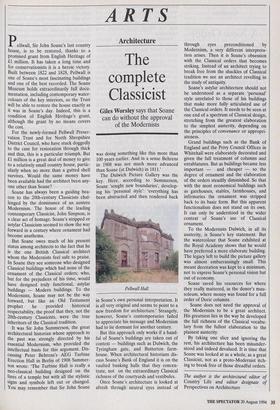ARTS
Architecture
The complete Classicist
Giles Worsley says that Soane can do without the approval of the Modernists
Pellwall, Sir John Soane's last country house, is to be restored, thanks to a promised grant from English Heritage of £1 million. It has taken a long time and for conservationists it is a heroic victory. Built between 1822 and 1828, Pellwall is one of Soane's most fascinating buildings and one of the best recorded. The Soane Museum holds extraordinarily full docu- mentation, including contemporary water- colours of the key interiors, so the Trust will be able to restore the house exactly as It was in Soane's day. Indeed, this is a condition of English Heritage's grant, although the grant by no means covers the cost.
For the newly-formed Pellwall Preser- vation Trust and for North Shropshire District Council, who have stuck doggedly to the case for restoration through thick and thin, this is a particular triumph. But £1 million is a great deal of money to give to a relatively small country house, partic- ularly when no more than a gutted shell survives. Would the same money have been available had the architect been any- one other than Soane?
Soane has always been a guiding bea- con to the 20th-century Classicists chal- lenged by the dominance of an austere Modernism. The house of the leading contemporary Classicist, John Simpson, is a clear act of homage. Soane's stripped or astylar Classicism seemed to show the way forward in a century where ornament had become anathema.
But Soane owes much of his present status among architects to the fact that he is the one British Classical architect whom the Modernists feel safe to praise. In Soane they see someone who designed Classical buildings which had none of the ornament of the Classical orders; who, but for the prejudices of his time, would have designed truly functional, astylar buildings — Modern buildings. To the Modernists, Soane may not be the way forward, but like an Old Testament prophet he provided historical respectability, the proof that they, not the 20th-century Classicists, were the true inheritors of the Classical tradition.
It was Sir John Summerson, the great architectural historian whose approach to the past was strongly directed by his essential Modernism, who provided the intellectual basis for this argument. Dis- cussing Peter Behrens's AEG Turbine Erection Hall in Berlin of 1908 Summer- son wrote: 'The Turbine Hall is really a neo-classical building designed on the lines of a temple but with all the stylistic signs and symbols left out or changed. You may remember that Sir John Soane was doing something like this more than 100 years earlier. And in a sense Behrens in 1908 was not much more advanced than Soane (at Dulwich) in 1811.'
The Dulwich Picture Gallery was the key. Here, according to Summerson, Soane 'sought new boundaries', develop- ing his 'personal style': 'everything has been abstracted and then rendered back Pellwall Hall in Soane's own personal interpretation. It is all very original and seems to point to a new freedom for architecture.' Strangely, however, Soane's contemporaries failed to appreciate his message and Modernism had to lie dormant for another century.
But this approach only works if a hand- ful of Soane's buildings are taken out of context — buildings such as Dulwich, the Tyringham gate, and Butterton farm- house. When architectural historians dis- cuss Soane's Bank of England it is on the vaulted banking halls that they concen- trate, not on the extraordinary Classical richness of the courtyards and vestibules.
Once Soane's architecture is looked at afresh through neutral eyes instead of through eyes preconditioned by Modernism, a very different interpreta- tion arises. Then it is Soane's obsession with the Classical orders that becomes striking. Instead of an architect trying to break free from the shackles of Classical tradition we see an architect revelling in the study of antiquity.
Soane's astylar architecture should not be understood as a separate 'personal' style unrelated to those of his buildings that make more fully articulated use of the Classical orders. It needs to be seen at one end of a spectrum of Classical design, stretching from the greatest elaboration to the simplest austerity, depending on the principles of convenance or appropri- ateness.
Grand buildings such as the Bank of England and the Privy Council Offices in Whitehall were elaborately decorated and given the full treatment of columns and entablatures. But as buildings became less important — and cheaper — so the degree of ornament and the elaboration of the orders steadily diminished. So that with the most economical buildings such as gatehouses, stables, farmhouses, and infirmaries the ornament was stripped back to its basic form. But this apparent functionalism does not stand on its own. It can only be understood in the wider context of Soane's use of Classical ornament.
To the Modernists Dulwich, in all its austerity, is Soane's key statement. But the watercolour that Soane exhibited at the Royal Academy shows that he would have preferred a more elaborate building. The legacy left to build the picture gallery was almost embarrassingly small. This meant decoration was kept to a minimum, not to express Soane's personal vision but out of economy.
Soane saved his resources for where they really mattered, in the donor's mau- soleum, where money was found for a full order of Doric columns.
Soane does not need the approval of the Modernists to be a great architect. His greatness lies in the way he developed the full richness of the Classical vocabu- lary from the fullest elaboration to the plainest austerity.
By taking one slice and ignoring the rest, his architecture has been misunder- stood and indeed devalued. It is time that Soane was looked at as a whole, as a great Classicist, not as a proto-Modernist itch- ing to break free of those dreadful orders.
The author is the architectural editor of Country Life and editor designate of Perspectives on Architecture


















































 Previous page
Previous page